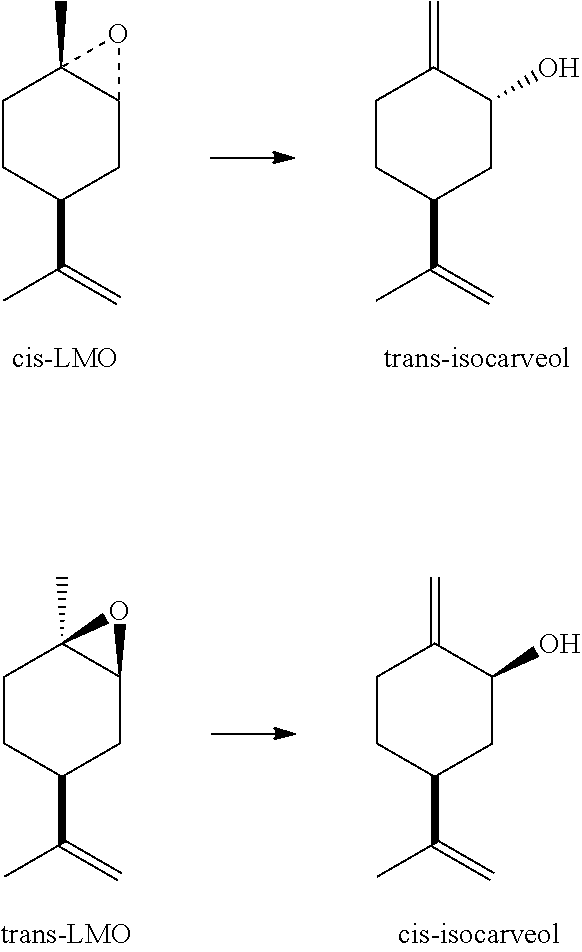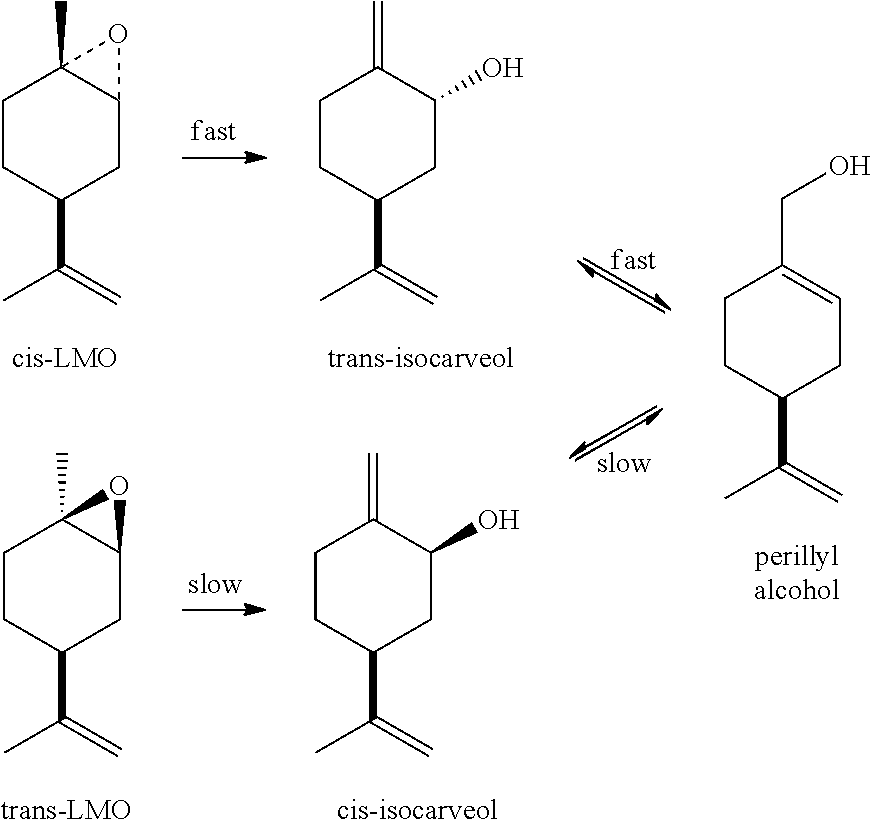Process for making perillyl alcohol
a technology of perillyl alcohol and process, which is applied in the field of perillyl alcohol making process, can solve the problems of difficult removal of by-products, low yield of desired alcohol, and large amount of wastewater, and achieves the effects of enhancing yield, reducing waste, and reducing the formation of high-molecular weight by-products
- Summary
- Abstract
- Description
- Claims
- Application Information
AI Technical Summary
Benefits of technology
Problems solved by technology
Method used
Image
Examples
example 1
Preparation of Perillyl Alcohol from a Mixture of Cis- and Trans-Isocarveols
[0033]A mixture of cis- and trans-isocarveols (100 g, isomer wt. ratio shown in Table 1) and ammonium vanadate (0.4 g) is agitated and heated at 160° C. for 8 h under a nitrogen atmosphere. Samples taken at 2-h intervals starting at reaction time=4 hours are analyzed by gas chromatography to follow the progress of the reaction. Results appear in Table 1.
[0034]
TABLE 1Conversion of Isocarveol Mixtures to Perillyl Alcohol versus Reaction TimeReaction time (h)0468trans-Isocarveol (wt. %)62.539.126.718.7cis-Isocarveol (wt. %)27.927.326.826.3Perillyl alcohol (wt. %)023.636.645.1
[0035]As shown in Table 1, trans-isocarveol is converted much more rapidly to perillyl alcohol than the cis-isomer. This experiment demonstrates: (1) that mixtures of cis- and trans-isocarveol can be directly isomerized to produce perillyl alcohol and (2) that trans-isocarveol is the preferred starting material for making perillyl alcohol.
example a
Preparation of Trans-Isocarveol
[0036]The procedure of U.S. Pat. No. 6,835,686 is generally followed, but with much less catalyst and less-stressed conditions. Thus, a mixture of limonene oxide (66% cis-, 34% trans-; 794 g), chromium octoate (12% Cr, product of Shepherd Chemicals, 0.53 g, 0.07 wt. %), and 2-aminophenol (0.66 g) is agitated and refluxed with a Dean-Stark trap for 1.5 h. The pot temperature at reflux increases from 198° C. to a maximum of 211° C. during the course of the reaction. After cooling, the reaction mixture is analyzed by gas chromatography. It contains: cis-LMO, 3.6% (95% conversion); trans-LMO, 29.7% (13% conversion), and trans-isocarveol, 51.3% (82% selectivity based on reacted cis-LMO). Fractionation of this mixture on a distillation column (20 theoretical plates) at a reduced pressure affords a mixture of cis-LMO and trans-LMO (240 g) and 99% pure trans-isocarveol (376 g). Additional trans-isocarveol can be recovered from recycle fractions.
example 2
Preparation of Perillyl Alcohol from Trans-Isocarveol
[0037]A mixture of trans-isocarveol (99%, 680 g, prepared as described in Example A), ammonium metavanadate (1.05 g), and BHT (0.28 g) is agitated and heated at 160° C. for 10 h under a nitrogen atmosphere. The resulting mixture, which contains (by gas chromatography) trans-isocarveol (32%), cis-isocarveol (2.7%), and perillyl alcohol (64.2%), is washed with 5% aqueous sodium hydroxide solution (80 g) at 60° C. The organic phase is neutralized with acetic acid and fractionated on a distillation column (20 theoretical plates) at reduced pressure. Distillation gives trans-isocarveol (185 g) that can be reused and perillyl alcohol (99.9% pure, 398 g). The yield of perillyl alcohol based on reacted trans-isocarveol is 92%, including recycle cuts. Optical rotation: [α]D22=+104.5° (neat) when starting with LMO prepared from d-limonene.
PUM
| Property | Measurement | Unit |
|---|---|---|
| temperature | aaaaa | aaaaa |
| temperature | aaaaa | aaaaa |
| boiling point | aaaaa | aaaaa |
Abstract
Description
Claims
Application Information
 Login to View More
Login to View More - R&D
- Intellectual Property
- Life Sciences
- Materials
- Tech Scout
- Unparalleled Data Quality
- Higher Quality Content
- 60% Fewer Hallucinations
Browse by: Latest US Patents, China's latest patents, Technical Efficacy Thesaurus, Application Domain, Technology Topic, Popular Technical Reports.
© 2025 PatSnap. All rights reserved.Legal|Privacy policy|Modern Slavery Act Transparency Statement|Sitemap|About US| Contact US: help@patsnap.com


